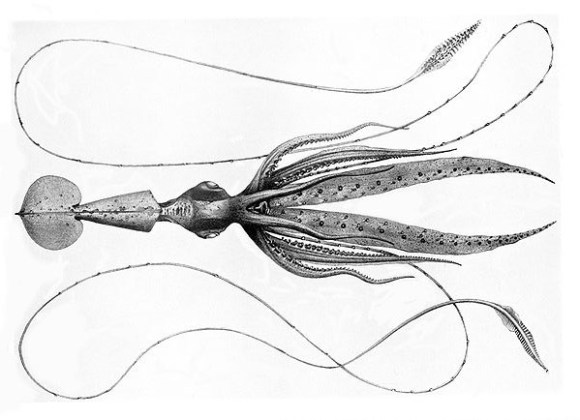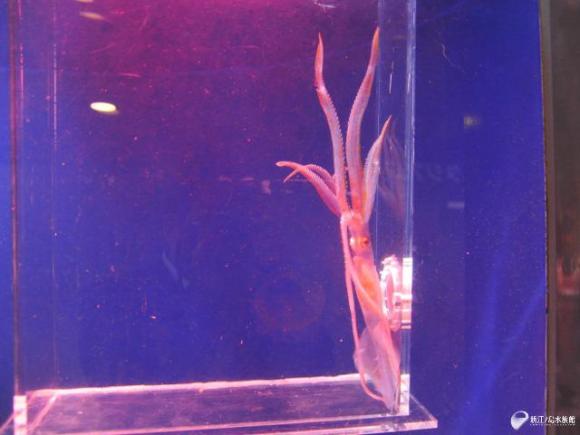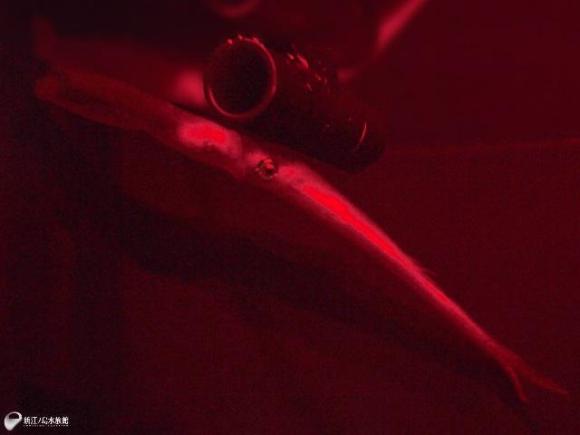 Deep below the ocean lives the squid Chiroteuthis, known in Japan by the name Yurei Ika (Phantom Squid). The Japanese name comes from its ghost-like fluttering and floating movement.
Deep below the ocean lives the squid Chiroteuthis, known in Japan by the name Yurei Ika (Phantom Squid). The Japanese name comes from its ghost-like fluttering and floating movement.
It’s a squid seldom seen by people who don’t have access to a submarine and can visit their habitat 200 to 600 meters beneath the ocean. So when they started turning up in unprecedented numbers around the southeastern coast of Japan, experts became understandably alarmed.
The phantom squid is not especially large at 60cm (body: 20cm), but even for a country very familiar with squid these guys are odd looking. They have 8 extremely thick tentacles, two of which are retractable, accompanied with two whip-like appendages.
Most people aren’t even aware of their existence, but the crew of a fishing vessel that scooped one up in their nets were on 15 November. Upon catching a living specimen they immediately sent it to the nearest aquarium, Enoshima Aquarium on the coast of Sagami Bay.
The aquarium welcomed this rarest of rare squid with open arms and prepared suitable living quarters. They equipped its tank with a dark red light to simulate its deep sea home and let them observe.
Sadly, the following day it died, likely as a result of the change in pressure. Marine ecologist, Masachika Tsuji explains:
“As far as I know, this is the first time to capture a live phantom squid. Usually, if deep sea fish come to the surface of the ocean then the lower pressure bursts their air bladder. However, because squid don’t have air bladders they can survive. That being said, coming to the surface causes considerable damage to their bodies. I have no idea why it came all this way.”
As the aquarium was lamenting their fleeting moment with such a rare creature the unexpected happened. The same day the museum was contacted about another fishing crew who caught another living phantom squid in Sagami Bay.
This time the museum was able to keep the squid alive for 3 days, but research on these creatures was extremely slim. Aquarium head keeper Madoka Kitajima tells the story:
“We tried feeding it different gobies and goldfish. We gave it a variety of thawed krill and herring, but it just wouldn’t eat. Phantom squid No. 2 came from off the coast of Atami and lived for 3 days, but it wouldn’t eat anything and died.”
As of 20 November there were two other phantom squids caught but they were not alive. It was also later discovered that back in October 10 phantom squid were discovered on the other side of Sagami Bay at Odawara Port.
So in the span of two months, 14 squid that are virtually never seen at the surface of the ocean were all caught within a limited area – an area which happens to be the location of the Great Kanto Earthquake of 1923. Mr. Tsuji is concerned.
“If it was just the one case on the 15th then it would have been written off as a fluke. But no longer, this must have been some kind of emergency evacuation from something major in the deep sea.
There seem to be many causes for the abnormal behavior of marine organisms. However, since the Tohoku Earthquake March 11 last year, there has been a growing risk of a massive earthquake epicenter in west Kanto. Most likely there could be crustal deformation of the seafloor in Sagami Bay.
In particular, it is also worrisome that the 1923 Great Kanto Earthquake which occurred off the coast of northwest Sagami Bay. One should also consider the Teishi Knoll undersea volcano that erupted in 1989 off the coast of Ito City in Shizuoka Prefecture. This may be a precursor to major volcanic activity in this area. The Phantom Squid may have begun to sense it.”
To make things more unsettling, last year we reported that an oarfish washed up on shore in Shizuoka Prefecture not too far from Sagami Bay on 21 December. In the article a reference was made to oarfish which washed up about year before the Tohoku Earthquake.
On the bright side, the fact that there is some major event under the ocean doesn’t necessarily mean it will have an impact to those of us on land.
To help lighten the mood I’ll leave you all with a fun science fact: the phantom squid are one of the few squid which has a penis. Most species of squid use their tentacles to impregnate females. G’night folks.
Source: Infoseek News via Hachima Kiko (Japanese)
Top Image: Wikipedia
Inset Images: New Enoshima Aquarium (Japnese)
Enoshima Aquarium (4 Phantom Squid Found November, 2012)
Odawara Port (10 Phantom Squid Found October, 2012)
Makinohara (1 Oarfish Found December, 2011)



 Creepy or cute? Come face to face with deep sea creatures as gachapon sushi toys!!
Creepy or cute? Come face to face with deep sea creatures as gachapon sushi toys!! A friendly reminder not to accidentally get squid sperm in your mouth, it hurts
A friendly reminder not to accidentally get squid sperm in your mouth, it hurts Stingray devours tank-mate squid at Japanese aquarium, shows what nature is really like 【Video】
Stingray devours tank-mate squid at Japanese aquarium, shows what nature is really like 【Video】 Cup Noodle instant ramen adds disturbingly named new topping: “almost squid!”
Cup Noodle instant ramen adds disturbingly named new topping: “almost squid!” Which Japanese conveyor belt sushi chain has the best squid sushi?【Taste test】
Which Japanese conveyor belt sushi chain has the best squid sushi?【Taste test】 McDonald’s new Happy Meals offer up cute and practical Sanrio lifestyle goods
McDonald’s new Happy Meals offer up cute and practical Sanrio lifestyle goods All-you-can-drink Starbucks and amazing views part of Tokyo’s new 170 meter-high sky lounge
All-you-can-drink Starbucks and amazing views part of Tokyo’s new 170 meter-high sky lounge Studio Ghibli glasses cases let anime characters keep an eye on your spectacles
Studio Ghibli glasses cases let anime characters keep an eye on your spectacles Beautiful Sailor Moon manhole cover coasters being given out for free by Tokyo tourist center
Beautiful Sailor Moon manhole cover coasters being given out for free by Tokyo tourist center More foreign tourists than ever before in history visited Japan last month
More foreign tourists than ever before in history visited Japan last month Super Nintendo World expansion gets delayed for several months at Universal Studios Japan
Super Nintendo World expansion gets delayed for several months at Universal Studios Japan Is the new Shinkansen Train Desk ticket worth it?
Is the new Shinkansen Train Desk ticket worth it? Princesses, fruits, and blacksmiths: Study reveals the 30 most unusual family names in Japan
Princesses, fruits, and blacksmiths: Study reveals the 30 most unusual family names in Japan Kyoto’s 100 Demons yokai monster parade returns!
Kyoto’s 100 Demons yokai monster parade returns! Beautiful new Final Fantasy T-shirt collection on the way from Uniqlo【Photos】
Beautiful new Final Fantasy T-shirt collection on the way from Uniqlo【Photos】 Disney princesses get official manga makeovers for Manga Princess Cafe opening in Tokyo
Disney princesses get official manga makeovers for Manga Princess Cafe opening in Tokyo Starbucks reopens at Shibuya Scramble Crossing with new look and design concept
Starbucks reopens at Shibuya Scramble Crossing with new look and design concept Foreign English teachers in Japan pick their favorite Japanese-language phrases【Survey】
Foreign English teachers in Japan pick their favorite Japanese-language phrases【Survey】 Japanese convenience store packs a whole bento into an onigiri rice ball
Japanese convenience store packs a whole bento into an onigiri rice ball We try out “Chan Ramen”, an underground type of ramen popular in the ramen community
We try out “Chan Ramen”, an underground type of ramen popular in the ramen community Studio Ghibli releases Kiki’s Delivery Service chocolate cake pouches in Japan
Studio Ghibli releases Kiki’s Delivery Service chocolate cake pouches in Japan Japan’s bone-breaking and record-breaking roller coaster is permanently shutting down
Japan’s bone-breaking and record-breaking roller coaster is permanently shutting down New definition of “Japanese whiskey” goes into effect to prevent fakes from fooling overseas buyers
New definition of “Japanese whiskey” goes into effect to prevent fakes from fooling overseas buyers Our Japanese reporter visits Costco in the U.S., finds super American and very Japanese things
Our Japanese reporter visits Costco in the U.S., finds super American and very Japanese things Studio Ghibli unveils Mother’s Day gift set that captures the love in My Neighbour Totoro
Studio Ghibli unveils Mother’s Day gift set that captures the love in My Neighbour Totoro Foreign passenger shoves conductor on one of the last full runs for Japan’s Thunderbird train
Foreign passenger shoves conductor on one of the last full runs for Japan’s Thunderbird train Domino’s Japan now sells…pizza ears?
Domino’s Japan now sells…pizza ears? New Japanese KitKat flavour stars Sanrio characters, including Hello Kitty
New Japanese KitKat flavour stars Sanrio characters, including Hello Kitty Kyoto creates new for-tourist buses to address overtourism with higher prices, faster rides
Kyoto creates new for-tourist buses to address overtourism with higher prices, faster rides Sales of Japan’s most convenient train ticket/shopping payment cards suspended indefinitely
Sales of Japan’s most convenient train ticket/shopping payment cards suspended indefinitely Sold-out Studio Ghibli desktop humidifiers are back so Totoro can help you through the dry season
Sold-out Studio Ghibli desktop humidifiers are back so Totoro can help you through the dry season Japanese government to make first change to romanization spelling rules since the 1950s
Japanese government to make first change to romanization spelling rules since the 1950s Ghibli founders Toshio Suzuki and Hayao Miyazaki contribute to Japanese whisky Totoro label design
Ghibli founders Toshio Suzuki and Hayao Miyazaki contribute to Japanese whisky Totoro label design Doraemon found buried at sea as scene from 1993 anime becomes real life【Photos】
Doraemon found buried at sea as scene from 1993 anime becomes real life【Photos】 Tokyo’s most famous Starbucks is closed
Tokyo’s most famous Starbucks is closed One Piece characters’ nationalities revealed, but fans have mixed opinions
One Piece characters’ nationalities revealed, but fans have mixed opinions We asked a Uniqlo employee what four things we should buy and their suggestions didn’t disappoint
We asked a Uniqlo employee what four things we should buy and their suggestions didn’t disappoint Pitch-black instant ramen added to Cup Noodle lineup to fill dark hole in our ramen-loving hearts
Pitch-black instant ramen added to Cup Noodle lineup to fill dark hole in our ramen-loving hearts Video of teen killing squid on Twitter sparks controversy over what we know about our food
Video of teen killing squid on Twitter sparks controversy over what we know about our food The top ocean-themed anime otaku most want to cool off with this summer ranked
The top ocean-themed anime otaku most want to cool off with this summer ranked NHK slips touching hidden message into TV listings on March 11
NHK slips touching hidden message into TV listings on March 11 These adorable animal cakes may be too cute to eat, but we’ll still try!【Photos】
These adorable animal cakes may be too cute to eat, but we’ll still try!【Photos】 Splatoon’s squid vs octopus Splatfest asks deep questions, ruins marriages
Splatoon’s squid vs octopus Splatfest asks deep questions, ruins marriages How to make the best dalgona cookies from Squid Game
How to make the best dalgona cookies from Squid Game New 3D aquarium show to let visitors experience a trip to the deep sea in Enoshima
New 3D aquarium show to let visitors experience a trip to the deep sea in Enoshima We prepared our own delicious amberjack sashimi and realized how much money it saved us【Pics】
We prepared our own delicious amberjack sashimi and realized how much money it saved us【Pics】 McDonald’s Japan celebrates Halloween by joining the dark burger revolution
McDonald’s Japan celebrates Halloween by joining the dark burger revolution We taste test the new Squid Ink Black Cup Noodle!
We taste test the new Squid Ink Black Cup Noodle! Starbucks’ Phantom Frappuccino: One of the hardest drinks to find in Japan
Starbucks’ Phantom Frappuccino: One of the hardest drinks to find in Japan Dom Dom’s Squid Devil Burger is here to shake up the gourmet scene like a tokusatsu bad guy
Dom Dom’s Squid Devil Burger is here to shake up the gourmet scene like a tokusatsu bad guy A feast for all sushi lovers — the amazing 1,000-yen lunch at Sushi Takehan Wakatsuki!
A feast for all sushi lovers — the amazing 1,000-yen lunch at Sushi Takehan Wakatsuki! We encountered the most frightening fried chicken in Ameyokocho in Tokyo, and ate it anyway
We encountered the most frightening fried chicken in Ameyokocho in Tokyo, and ate it anyway Anime’s Tetsuwan Atom/Astro Boy shows up on a pedestrian walk signal in Japan
Anime’s Tetsuwan Atom/Astro Boy shows up on a pedestrian walk signal in Japan
Leave a Reply